Semiconductor Cooling System
Kontaktieren Sie uns noch heute für die perfekte Lösung zur Temperaturkontrolle
Semiconductor cooling system is also called semiconductor refrigeration module, semiconductor thermoelectric refrigeration module, thermoelectric refrigeration module, thermoelectric refrigerator, etc. It is a temperature control device composed of a semiconductor refrigeration chip and a heat transfer structure added on both sides. The heat transfer structures on both sides of the semiconductor cooling system exchange heat between the cooling capacity of the cold surface of the refrigeration chip and the space to be cooled, and at the same time dissipate the heat from the hot surface of the refrigeration chip in a timely manner. We classify semiconductor refrigerators into Air to Air series, Plate to Air series, Plate to Liquid series, Liquid to Air series, and Liquid to Liquid series based on different heat transfer methods.
1.Air to Air series
It adopts the forced air cooling mode of cold and hot surfaces, and uses the impact flow generated by the fan on the air to achieve better heat exchange. Common applications include sample storage chambers in medical and analytical instrumentation, electronic enclosures, and compartment storage in food and beverage applications.
![]()
![]()
2.Plate to Air series
Heat dissipation through air, plate conduction cooling, direct contact with the cooling object, providing cooling capacity, widely used in medical equipment, test equipment and other products, suitable for small sample storage rooms used in medical and analytical instruments, point cooling of laser systems or Sensitive optical electronic equipment used in industrial and telecommunications markets.
3.Plate to Liquid series
Through liquid heat dissipation, aluminum plate cooling provides reliable heat dissipation performance for cooling or heating objects directly connected to the cold plate, or enclosures connected to the cold plate through thermally conductive containers. Liquid circulation usually transfers heat to the surrounding air through a circulation pump and a “liquid-to-air” heat exchanger. Products are widely used in medical diagnostic instruments, laser cooling, analytical instruments, and products that can directly come into contact with constant temperature.
4. Liquid to Air series
Through air heat dissipation, liquid circulation refrigeration, and then heat exchange with the equipment being cooled, provides refrigeration capacity. For cooling of body tissue or elsewhere including laser or microwave thermal therapy; cooling or heating of capillary electrophoresis; cooling of power lasers and other sensitive electronic equipment.
5. Liquid to Liquid series
Liquid components directly cool an object connected to a cold plate, which is used to cool or heat the liquid or gas flowing through the component. Liquid circulation usually transfers heat to the surrounding air through a circulation pump and a “liquid-to-air” heat exchanger. It is widely used in medical diagnostic instruments, analytical instruments, process fluids and products that can directly come into contact with constant temperature.
E-Mail: info@lneya.com WeChat ID: +8615251628237 WhatsApp: +86 17851209193
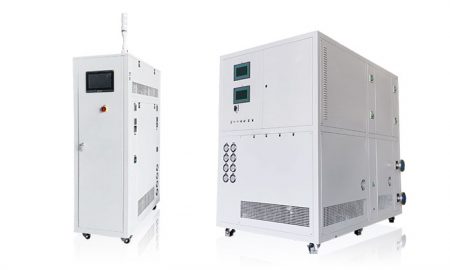
TES-Reihe (Benutzerdefinierte Designs)
Geeignet für die präzise Temperaturkontrolle von elektronischen Bauteilen. Bei der Herstellung von elektronischen Halbleiterkomponenten für raue Umgebungen umfassen die Phasen der IC-Gehäusemontage sowie der Entwicklungs- und Produktionstests auch elektronische Wärmetests und andere Simulationen von Umwelttests.
| Temperaturbereich | Serie -45°C ~ +250°C | Serie -85°C ~ +200°C | Serie -60°C ~ +200°C | ||||||
| Kühlleistung | 0,3 ~ 25kW | 0,25 ~ 25kW | 3 ~ 60kW | ||||||
| Hinweis: Jeder Temperaturbereich von -150℃ ~ +350℃ und jede Kühlleistung kann angepasst werden | |||||||||

LTS-Serie (fluorierte Flüssigkeit) (Benutzerdefinierte Designs)
Weit verbreitet in der Halbleiterfertigung zur Regelung der Temperatur der Reaktionskammer, der Temperatur der Wärmesenke und der Temperaturregelung der nicht brennbaren Flüssigkeit des Wärmeträgers.
| Temperaturbereich | -20°C ~ +80°C Reihe | Serie -45°C ~ +80°C | Serie -60°C ~ +80°C | Serie -80°C ~ +80°C | |||||
| Durchflusskontrolle | 7 ~ 45 L/min | 7 ~ 45 L/min | 7 ~ 45 L/min | 7 ~ 45 L/min | |||||
| Hinweis: Jeder Temperaturbereich von -150℃ ~ +350℃ und jede Kühlleistung kann angepasst werden | |||||||||
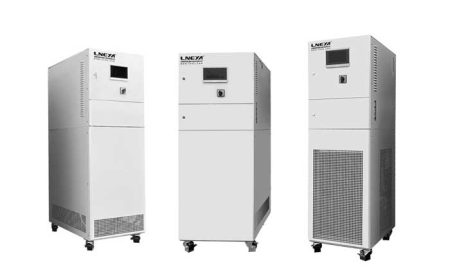
FLT-Reihe (Benutzerdefinierte Designs)
Das Halbleiter-Temperaturregelungssystem Chiller wird hauptsächlich für die präzise Temperaturregelung in der Halbleiterproduktion und im Testprozess verwendet. Er wurde speziell für die Halbleiterindustrie entwickelt und konstruiert.
| Temperaturbereich | +5°C ~ +40°C | -25°C ~ +40°C | -45°C ~ +40°C | -80°C ~ +80°C | -100°C ~ +80°C | ||||
| Kühlleistung | 6 ~ 40kW | 2 ~ 15kW | 1 ~ 8kW | 0,6 ~ 3kW | 1,5 ~ 3kW | ||||
| Hinweis: Jeder Temperaturbereich von -150℃ ~ +350℃ und jede Kühlleistung kann angepasst werden | |||||||||

FLTZ-Serie Frequenzumwandlung (Benutzerdefinierte Designs)
Die Temperaturregelung, die Umwälzpumpe und der Kompressor werden alle durch Frequenzumwandlung eingestellt.
| Temperaturbereich | -30°C ~ +40°C | ||||||||
| Kühlleistung | 5 ~ 11kW | ||||||||
| Hinweis: Jeder Temperaturbereich von -150℃ ~ +350℃ und jede Kühlleistung kann angepasst werden | |||||||||
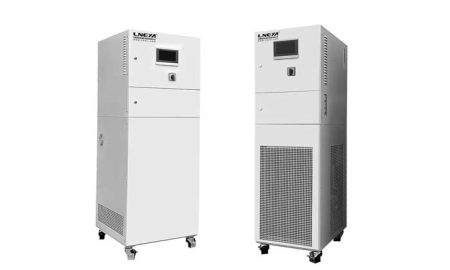
ETCU-Reihe (Benutzerdefinierte Designs)
Art des Wärmeaustauschs
System ohne Kompressor
| Temperaturbereich | +5°C ~ +90°C | ||||||||
| Kühlleistung | 5 ~ 30kW | ||||||||
| Hinweis: Jeder Temperaturbereich von -150℃ ~ +350℃ und jede Kühlleistung kann angepasst werden | |||||||||

Baureihe ZLFQ (Benutzerdefinierte Designs)
Kühlmittelverteilereinheit
Flüssigkeitskühlgeräte eignen sich für die Prüfung von Halbleitern, die Prüfung elektronischer Geräte bei konstanter Temperatur, die Kühlung der Serverinfrastruktur und andere Orte, an denen die Temperatur von Flüssigkeiten kontrolliert wird.
| Temperaturbereich | +5°C ~ +35°C | +5°C ~ +35°C | |||||||
| Kühlleistung | 15 ~ 150kW | 200 ~ 500kW | |||||||
| Hinweis: Jeder Temperaturbereich von -150℃ ~ +350℃ und jede Kühlleistung kann angepasst werden | |||||||||

MD-Thermofutter-Serie (Benutzerdefinierte Designs)
Es wird für die Prüfung von HF-Bauteilen und Leistungsbauteilen mit hoher Dichte (IGBTs und MOSFETs) verwendet und kann auch für die schnelle Kühlung von flachen Laborplatten (Plasma, biologische Produkte, Batterien) usw. eingesetzt werden.
| Temperaturbereich | -75°C ~ +225°C | ||||||||
| Temperaturgenauigkeit | ±0.1℃ | ||||||||
| Hinweis: Jeder Temperaturbereich von -150℃ ~ +350℃ und jede Kühlleistung kann angepasst werden | |||||||||
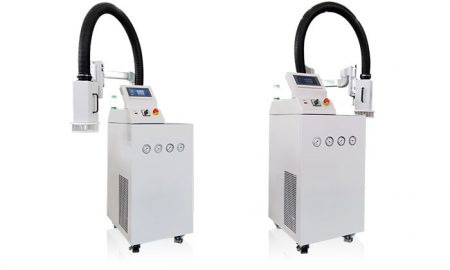
Strahlenschlagprüfmaschine der Serie AES
Temperaturregelbereich: -120°C ~ +225°C
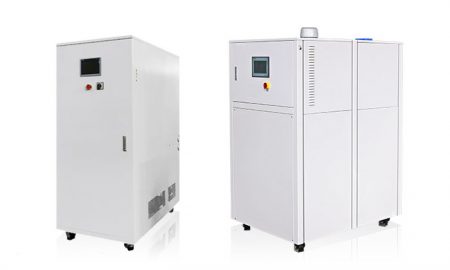
AI-Serie Umluft-Temperaturregelsystem
Temperaturregelbereich: -105°C ~ +125°C

Temperaturregelbereich: -110°C ~ -40°C
YQH Serie VOCs Abgaskondensationsrückgewinnungsgerät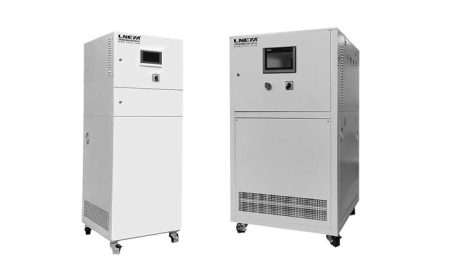
Angewandt auf die Rückgewinnung von Gaskondensation und Verflüssigung. Die Abgase oder andere elektronische Gase werden über den Saugzugventilator (Vakuumpumpe) an das Gerät angeschlossen, verflüssigt, gesammelt und durch Absenken der Temperatur in den Sammelbehälter abgeschieden, und andere Gase werden abgeleitet, um die Kondensation, Erfassung und Rückgewinnung des Gases zu realisieren.
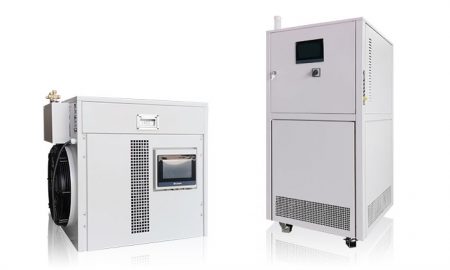
Baureihe ZLJ / SLJ (Benutzerdefinierte Designs)
Er ist für Orte geeignet, an denen die Wärmeaustauschfläche des Wärmetauschers klein, die Wärmeaustauschkapazität jedoch groß ist. Das Kältemittel wird direkt in den Ableiter geleitet, um zu verdampfen, und das Gas im Raum wird durch den Kondensationseffekt an der Oberfläche des Ableiters schnell aufgefangen.
| Temperaturbereich | -40°C ~ -15°C | -80°C ~ -50°C | -150°C ~ -110°C | ||||||
| Kühlleistung | 0,5 ~ 4kW | 0,37 ~ 3,1kW | 2,5 ~ 9kW | ||||||
| ZLJ-Reihe | SLJ-Reihe | ||||||||
| Hinweis: Jeder Temperaturbereich von -150℃ ~ +350℃ und jede Kühlleistung kann angepasst werden | |||||||||
 LNEYA
LNEYA
 简体中文
简体中文


















































































